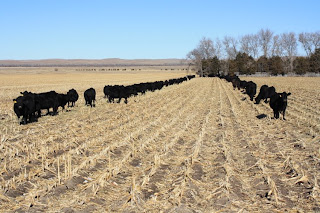More Cows Than People
According to the Nebraska Beef Council
January 2006 figures illustrate that Nebraska continues to have far more cattle than people. Cattle outnumber Nebraskans nearly 4 to 1. Cows number 1.93 million, versus Nebraska residents who number just 1.7 million.
 This time of year in the Platte River Valley, cattle will most often be seen on the corn fields, eating up the stalks and waste corn before the geese, Sandhill cranes and other migratory birds move in. And no, cattle don't usually line up in parade formation. These have just been "caked" so they're lining up to eat their fill.
This time of year in the Platte River Valley, cattle will most often be seen on the corn fields, eating up the stalks and waste corn before the geese, Sandhill cranes and other migratory birds move in. And no, cattle don't usually line up in parade formation. These have just been "caked" so they're lining up to eat their fill.The cows have been dropping their calves for nearly a month now, but it is amazingly hard to get a good picture of a group of black cows and calves. It all turns out to look like just one black blob. So, until I can find some cute red-white-faced mamas and babies, these will have to do.
The beef people have some more interesting facts about the Nebraska Cattle Industry:
The importance of cattle feeding to Nebraska’s economy runs deeper than in other states. Nearly 5 million head are finished and marketed in Nebraska, a state with a population of 1.7 million residents. Texas markets a third more cattle than Nebraska, but it has a population of 20.1 million residents is nearly 12 times larger. Iowa markets less than 2 million cattle and has 1.1 million more residents than Nebraska. This means such states depend on other industries. Their standard of living isn’t nearly as dependent on cattle feeding as Nebraska’s.
Nebraska has a unique mix of natural resources. Cattle turn grass from 24 million acres of rangeland and pasture, more than one half of Nebraska’s land mass, into protein and many other products for humans. The land grazed by cattle allows more people to be fed than would otherwise be possible. More than one billion bushels of corn are produced here each year, 40% of which is fed to livestock in the state. Cattle producing families, who make their living from the land, have a strong incentive to protect their animals and the environment.
Beef, it's what's for dinner. (I just had to say that)
Thanks for stopping by. The coffee is always on.



707B79BD6D
ReplyDeleteGörüntülü Seks
Ücretli Show
Skype Show